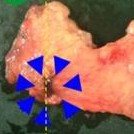Acinar Cell Carcinoma of the Pancreas: A Possible Role of S-1 as Chemotherapy for Acinar Cell Carcinoma. A Case Report
Abstract
Context Acinar cell carcinoma of the pancreas is a rare malignancy, accounting for 1-2% of pancreatic exocrine malignancies. This rarity makes it difficult to standardize a protocol of treatment for acinar cell carcinoma. Case report A 71-year-old male without any particular past history was referred to our institute with abdominal distention and mild liver dysfunction. Computed tomography (CT) revealed a cystic lesion with a diameter of 3.5 cm, which originated from the neck of pancreas and had solid nodules inside. Several nodules were demonstrated surrounding the cystic tumor. Laparotomy and histological study demonstrated peritoneal dissemination of acinar cell carcinoma. The patient was treated with S-1 monotherapy (80 mg/m2 for four weeks with a two-week interval as one cycle). After one cycle of S-1 monotherapy, CT demonstrated remarkable shrinkage of the main tumor and disappearance of the nodules on the peritoneum. The patient underwent a radical distal pancreatectomy. The patient was then treated with 16 cycles of S-1 monotherapy after the radical pancreatectomy and remains without any recurrence of the disease two years later. Conclusion Initially inoperable acinar cell carcinoma was treated by monotherapy using S-1, resulting in curative operation and two years disease free survival post operation. S-1 might be more effective on acinar cell carcinoma, rather than gemcitabine.
Downloads
References
Chen J, Baithun SI. Morphological study of 391 cases of exocrine pancreatic tumors with special reference to the classification of exocrine pancreatic carcinoma. J Pathol 1985;146:17-29. [PMID 2989468]
Seth AK, Argani P, Campbell KA, Cameron JL, Pawlik TM, Schulick RD. et al. Acinar cell carcinoma of the pancreas: an institution series of resected patients and review of the current literature. J Gastrointest Surg 2008;12:1061-1067. [PMID 17957440]
Schmidt CM, Matos JM, Bentrem DJ, Talamonti MS, Lillemoe KD, Bilimoria KY. Acinar cell carcinoma of the pancreas in the UnitedState: prognostic factors and comparison to ductal adenocarcinoma. J Gastrointest Surg 2008;12:2078-2086. [PMID 18836784]
Kitagami H, Kondo S, Hirano S, Kawakami H, Egawa S, Tanaka M. Acinar cellcarcinoma of the pancreas: clinical analysis of 115 patients from PancreaticCancer Registry of Japan Pancreas Society. Pancreas. 2007 Jul;35(1):42-6. [PMID 17575544]
Holen KD, Klimstra DS, Hummer A, Gonen M, Conlon K, Brennan M, Saltz LB. Clinical characteristics and outcomes from an institutional series of acinar cell carcinoma of the pancreas and related tumors. J Clin Oncol 2002;20:4673-4678. [PMID 12488412]
WisnoskiNC, Townsend Jr. CM, Nealon WH, Freeman JL, Ria TS. 672 patients with acinar cell carcinoma of the pancreas: a population-based comparison to pancreatic adenocarnoma. Surgery 2008;144:141-148. [PMID 18656619]
Ukei T, Okagawa K, Uemura Y, Miyauchi K, Kaneko T, Mizunoya S, Monden M. Effective intra-arterial chemotherapy for acinar cell carcinoma of the pancreas. Dig Surg. 1999;16:76-9. [PMID 9949272]
Kobayashi S, Ishikawa O, Ohigashi H, Yamada T, Sasaki Y, Imaoka S, et al. Acinar cell carcinoma of the pancreas successfully treated by en bloc resection and intraperitoneal chemotherapy for peritoneal relapse: a case report of a 15-year survivor. Pancreas. 2001;23(1):109-12. [PMID 11451140]
Lee JL, Kim TW, Chang HM, Lee SK, Kim MH, Kang YK, et al. Locally advanced acinar cell carcinoma of the pancreas successfully treated bycapecitabine and concurrent radiotherapy: report of two cases. Pancreas. 2003;27:e18-22. [PMID 12826914]
Antoine M, Khitrik-Palchuk M, Saif MW. Long-term survival in a patient withacinar cell carcinoma of pancreas. A case report and review of literature. JOP. 2007;8:783-9. [PMID 17993731]
Riechelmann RP, Hoff PM, Moron RA, da Camera Lopes LH, Buzaid AC. Acinar cell carcinoma of the pancraeas. Int J Gastrointestinal Cancer 2003;34:67-72. [PMID 15361637]
Rosenberg ML. Moore MJ, Cripps MC, Andersen JS, Portnoy RK, Burris III HA, et al. A phase II trial of gemicitabine in patients with 5-FU refractory pancreas cancer. Ann Oncol 1996;7:347-353. [PMID 8805925]
Oettle H, Post S, Neuhaus P, Gellert K, Langrehr J, Ridwelski K, et al. Adjuvant chemotherapy with gemcitabine vs observation in patients undergoing curative-intent resection of pancreatic cancer. JAMA 2007;297:267-277. [PMID 17227978]
Sorscher SM. Metastatic acinar cell carcinoma of the pancreas responding to gemcitabine, 5-fluorouracil and leucovorin therapy: a case report. Eur J Cancer Care. 2009;18:318-319. [PMID 19445023]
Seki Y, Okusaka T, Ikeda M, Morizane C, Ueno H. Four cases of pancreatic acinar cell carcinoma treated with gemcitabine or S-1 as a single agent. Jpn J ClinOncol. 2009;39:751-755. [PMID 19666905]
Shirasaka T, Shimamoto Y, Ohshimo H, Yamaguchi M, Kato T, Yonekura K, et al. Development of a novel form of an oral 5-fluorouracil derivative (S-1) directed to the potentiation of the tumor selective cytotoxicity of 5-fluorouracil by two biochemical modulators. Anticancer Drug 1996;7:548-557.
Ueno H, Okusaka T, Ikeda M, Takezako Y. An early phase II study of S-1 in patients with metastatic pancreatic cancer. Oncology 2005;68:171-178. [PMID 16006754]
Okusaka T, Funakoshi A, Furuse J, Boku N, Yamao K, Ohkawa S, Saito H. A late phase II study of S-1 for metastatic pancreatic cancer. Cancer Chemother Pharmacol 2008;61:615-621. [PMID 17520253]

Copyright (c) 2014 Tameyoshi Yamamoto, Hiroki Ohzato, Mutumi Fukunaga, Hiroshi Imamura, Hiroshi Furukawa

This work is licensed under a Creative Commons Attribution 4.0 International License.
As a member of Publisher International Linking Association, PILA, iMedPub Group’s JOP follows the Creative Commons Attribution License and Scholars Open Access publishing policies. Journal of the Pancreas is the Council Contributor Member of Council of Science Editors (CSE) and following the CSE slogan Education, Ethics, and Evidence for Editors.